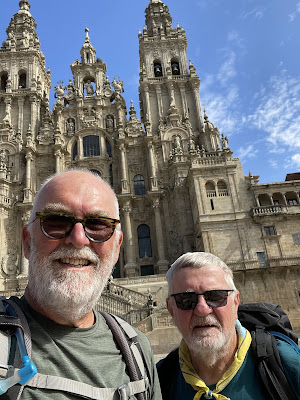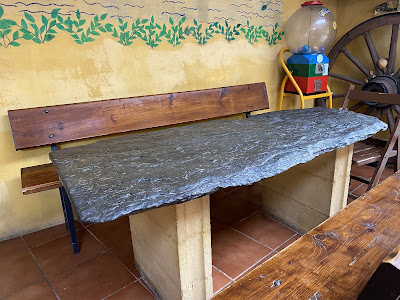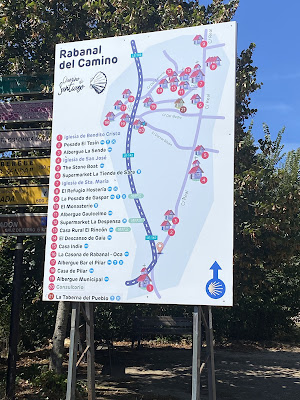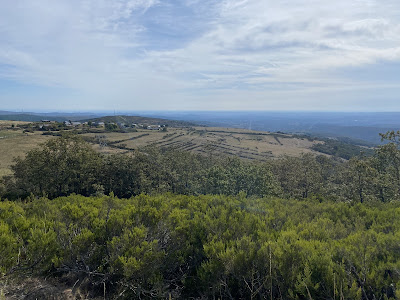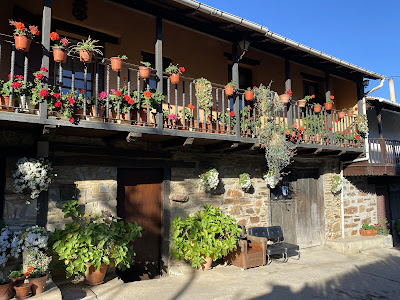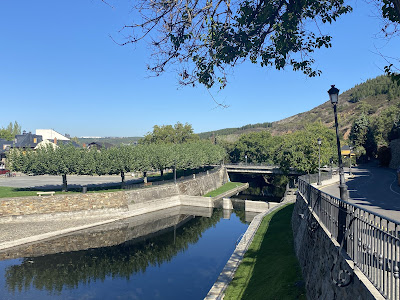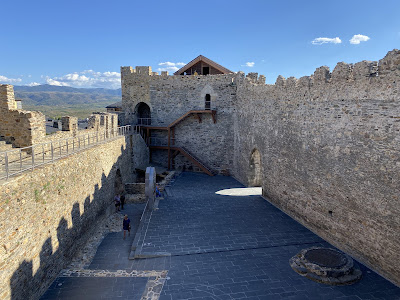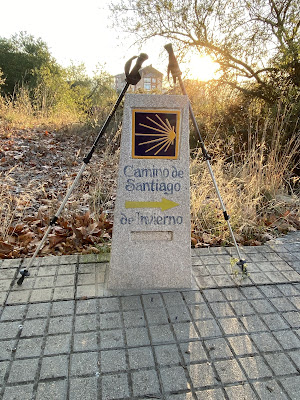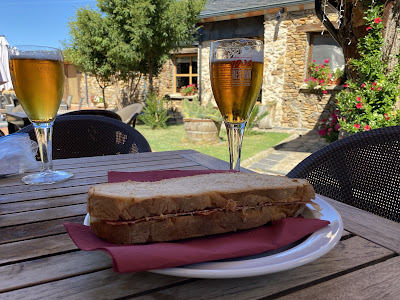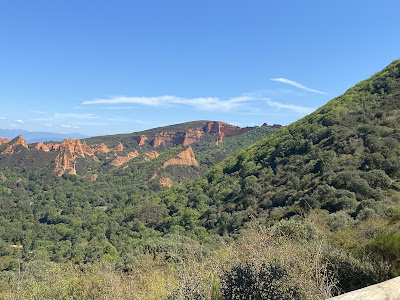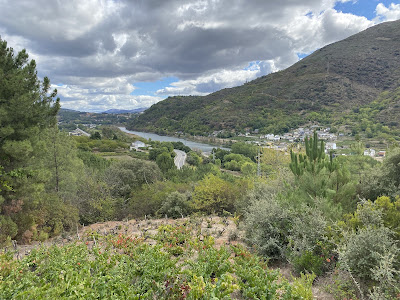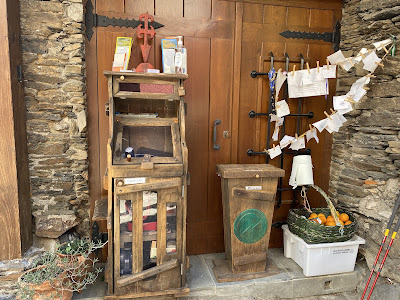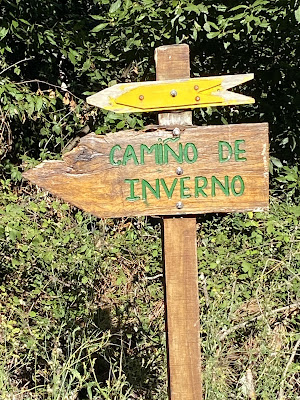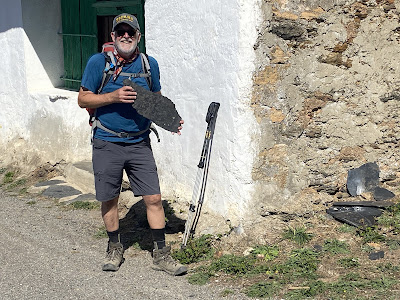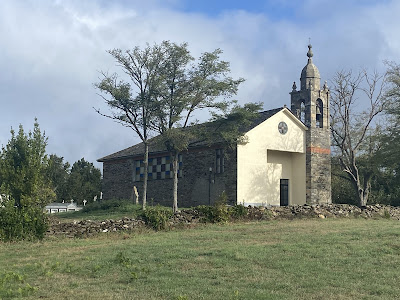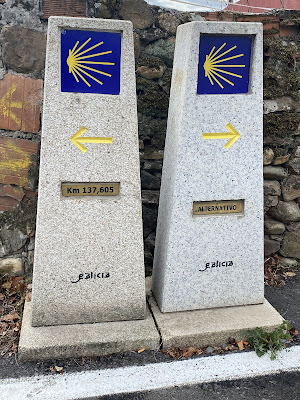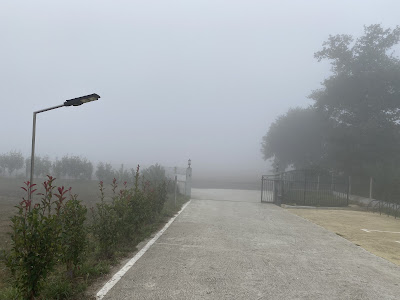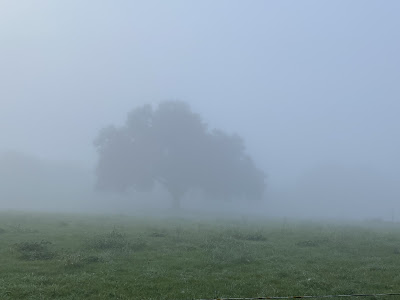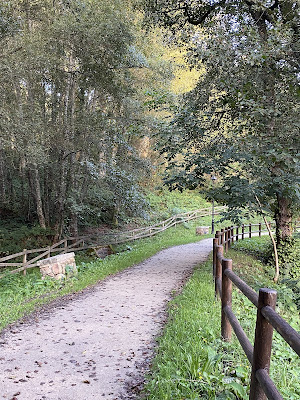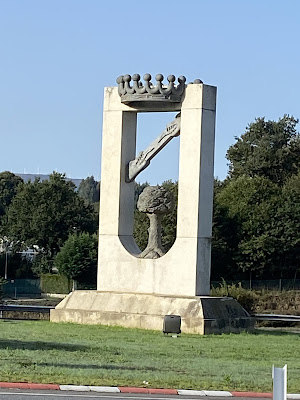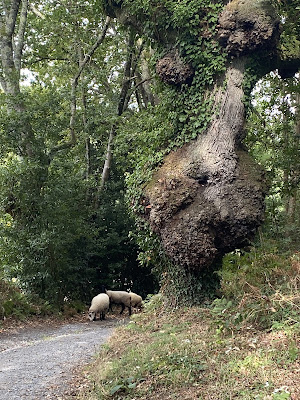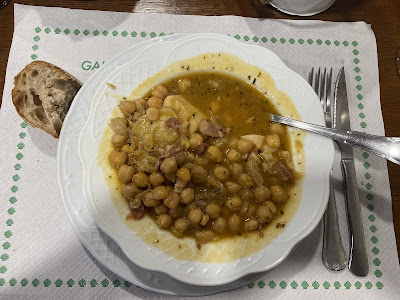Camino 2022 - the Invierno & More
"All truly great thoughts are conceived while walking." - Friedrich Nietzche
Introduction
While
there are many pilgrimage routes in Spain and other parts of Europe, this blog focuses principally on my Camino Invierno walk in Spain during September and October 2022. Prior to
fall 2022, I had walked three Caminos (2013, 2016 and 2019) in Spain and before
even arriving home after the 2019 experience I was thinking about a future
walk. Having another of these adventures was delayed due to the COVID-19 global
pandemic. By the end of 2021, however, vaccination programs were underway and provided
hope for safe international travel in the not-too-distant future. This led to
my friend and Camino companion (Gray) to initiate discussions in early 2022 about Camino # 4.
Why a Camino?
There
are many reasons for people to walk a Camino – the physical challenge, having a unique or new adventure, experiencing another culture, for a spiritual or
other type of pilgrimage, doing something beyond the ordinary with friends, or some other reason. Often it is a blend of these things that motivate people, not simply one reason. In my case, it has been a combination of pilgrimage,
experiencing the various dimensions of another culture, and sharing a truly
unique experience with close friends. The motivation for such a journey
is a personal choice, which means there truly is a unique tapestry of people
on all Camino routes.
What is the Camino?
The Spanish word “camino” translates to road or way. For hundreds of years a Camino walk generally has been considered as a pilgrimage route related to a religious or spiritual journey. There are scores of routes in Europe and other parts of the world that are in some way intended as a pilgrimage route for many. Spain seems to have the greatest number of routes of any European country, with the most well-known being the Camino de Santiago (Way of St. James). There is an extensive network of routes that lead to the cathedral in Santiago de Compostela in northwestern Spain, where tradition has it that the remains and relics of Saint James (Santiago) are buried. When many people refer to “The Camino” they are referring to the route starting in St. Jean Pied de Port (France) and ending at the cathedral in Santiago de Compostela (aka Camino Frances).
"I love to walk. Walking is a spiritual journey and a reflection of living. Each of us must determine which path to take and how far to walk; we must find our own way, which is right for one may not be for another. There is no single right way to deal with late-stage cancer, to live a life, or approach death, or to walk an old mission trail." - Eddie Littlefield Sundby
Pilgrimage – Some History
For
many centuries, pilgrimage of some type has been a practice of religious
traditions. For example, pilgrimage took the form of the Jewish exodus from
Egypt, Islam’s Hajj to Mecca, vision quests, walkabouts, and classic heroic
journeys about leaving home. In the fourth century, many Christians began to
travel to Jerusalem as a pilgrimage. It seems that pilgrimages took on new forms
over the centuries; with spirituality almost always being integral.
The spiritual aspect of pilgrimage can be a search for direction, enlightenment, a new perspective, seeking answers, penance, preparing for significant change or transition in one’s life. Pilgrimage is generally intended to assist people with aspects of personal or spiritual growth.
During the Middle Ages the routes to Rome or Jerusalem were travelled annually by many people. However, the Plague (Black Death), Protestant Reformation, and political unrest in 16th century Europe led to a decline in interest. It was during this period that Santiago de Compostela became the preferred destination for Christian pilgrims. While only a few hundred pilgrims registered annually at the pilgrims’ office in Santiago in the 1980s, less than a decade later (October 1987) the Camino de Santiago was declared the first European Cultural Route by the Council of Europe. Since then, interest in the Camino de Santiago has steadily increased.
One’s motivation for walking a Camino is a personal decision regardless of whether or not they consider themselves to be on a spiritual pilgrimage or going for a long walk.
Credential
and Compostela
Most people walking a Camino in modern time would like evidence of what they have accomplished. This is provided by the Pilgrim’s Office in Santiago de Compostela. A certificate of completion or Compostela is provided by the Pilgrim’s Office operated by the Cathedral in Santiago. To receive a Compostela, you must:
- make the pilgrimage for religious or spiritual reasons, or at least an attitude of searching,
- walk the last 100 km on foot or horseback, or the last 200 km if traveling by bicycle; your credential must be stamped twice a day on the last 100 km for those walking or on horseback, or on the last 200 km for those cycling,
- you must collect stamps/impressions in a Credential del Peregrino from the places (towns, villages and cities) passed through to certify that you have walked at least 100 km on a specific route; stamps can be acquired from a variety of places such churches, hostels/albergues, hotels, monasteries, cathedrals, bars, restaurants/cafes, town halls, etc.
A credential is sort of like a passport that has to be shown when staying at a albergues operated by a church/religious organization or a municipality. Credentials have several spaces for stamps from places along the way. Each stamp is different with a wide variety of designs, some are quite artistic and/or have a pilgrimage theme. (See below)
Credential
Compostela
A Few Statistics
Since the late 1980s the number of people walking a Camino route to Santiago has steadily increased with people coming from around the world. While the number of pilgrims declined during 2020 and 2021 due to the COVID-19 pandemic, more than 437,510 pilgrims received a certificate of completion (Compostela) in 2022 at the pilgrim’s office in Santiago. Of this total, 2,352 people received a Compostela after walking the Camino Invierno. Here are a few other statistics (2022) that may be of interest:
- 226,447 people received a Compostela after walking the Camino Frances;
- 51.8 % of all pilgrims on all routes walked the Camino Frances;
- Sarria was the starting point for more people than any other location – 131,820 or 30.8 % of the total number of people receiving a Compostela.
Our Pilgrimage Spiritual Practices
On the
four Caminos walked thus far, my friends and I have used certain practices for spiritual
or religious reflection.
- At the beginning or early on each day of walking, a short reflection or Biblical passage was read. This provided topics for conversation as well as personal reflection throughout the day.
- While we walked together much of the time, there were periods every day when we walked alone that provided a time for solitude and reflection.
- We
kept our own personal journal to write about each day – maybe
some facts combined with notes about what was on our mind, what
we experienced, or how we were responding to certain situations. The
personal notes were not intended for sharing.
- Intentional
placing of small stones or pebbles at the foot of the Iron Cross (3
occasions), on the top of granite bollards, or another location where we would
stop for a time of a reflection; these rituals allowed us to express gratitude
and/or pray for someone or a situation. When not on the route with the Iron
Cross, we selected another suitable location for placing the small stones and a time of reflection.
- When possible, we would quite regularly stop at an open church for solitude and prayer. Unfortunately, this happened only once when walking the Invierno.
Planning
As
with previous Camino walks, we decided that mid-September would be a good time
to start walking as had been the case previously – not as hot as July and
August and because the various Camino routes are less busy in the fall. After
considering a few options, we decided on a route that would be mostly new to us
and less travelled than most routes. We chose the Camino Invierno (Winter
Way) with a bit of a twist – start walking in Astorga on the Camino Frances
(busiest route) for three days before shifting to the Invierno where it starts in
the city of Ponferrada. We were familiar with the three-day Camino Frances section
as we had walked it twice previously and enjoyed it. Near the end
of the route the Invierno merges with the Camino Sanabres and for the last two
days we walked the same route as in 2019.
Some aspects of planning for the Invierno were a bit more complicated than with previous Caminos because: 1) it is a somewhat more remote route and not heavily travelled which means it has less infrastructure supporting pilgrims than on many other routes; 2) concerns about possible COVID-19 exposure, so we wanted to stay in lodging where we would have a private room; 3) not all towns had lodging available and the distances between towns often varied substantially; and 4) often it was not easy to access food during the day so we had to ensure that we planned for this by purchasing food before walking on sections without cafes/bars. Even with these challenges, a good daily walking plan was developed and lodging, and our flights were booked by early summer 2022.
High-level details about our journey:
- departed Victoria on September 14; arrived in Madrid in the late morning on September 15 and stayed there for two nights,
- travelled from Madrid to Astorga by bus on September 17,
- started walking from Astorga on September 18,
- walked three days on the Camino Frances (Astorga to Ponferrada), arriving in Ponferrada on September 20,
- started Camino Invierno on September 21 and arrived in Santiago on October 6,
- in total we walked 18 days with one rest day (September 28) in the city of Monforte de Lemos (pop. 20,000),
- the overall route distance walked was about 330 km; however, we took alternative routes for some sections, so it is estimated that our overall route walking distance was close to 350 km; in virtually every town where we stopped overnight, we did a substantial amount of local walking to explore; with all this walking combined the overall distance walked was at least 400 km,
- average daily route walking distance was just under 19 km,
- the accrued elevation estimate spread over the total route we walked was 14,870 metres or 48,786 feet (based on Brierley guidebook).
Basic map of route we walked from Ponferrada to Santiago
As expected, we encountered a limited number of other pilgrims on the Invierno and on some days we did not see any other pilgrims. On the first three days of walking on the Camino Frances, however, we encountered more pilgrims than we did on the entire Invierno route. Near the end of our walk, the number of pilgrims increased a bit after the Invierno and Sanabres routes merged, but still much less than on the 3-day section on the Frances.
A bit of background on the Camino Invierno
The Camino Invierno is the Jacobean
route that connects Ponferrada with Santiago de Compostela via the valley
of the River Sil. This route crosses the eastern Galician Mountain
range at lower levels than is the case on the Camino Frances. Because this road
historically was used by Roman legions, medieval
muleteers, and Napoleonic troops, it
also served as an alternate route for pilgrims traveling to
Santiago in winter, enabling them to avoid the notable snow of the O’Cebreiro
section (Frances route) which was common in the coldest months.
After the Invierno starts in Ponferrada it does not connect with the Frances route again and merges with the Sanabres route between Lalin and A Laxe.
While the number of pilgrims choosing this path has increased in recent years it has far fewer pilgrims than most routes. Nevertheless, the Invierno is increasingly an alternate way for some who have already walked the Camino Frances or Camino Portuguese and are looking for a route with more solitude, a change of scenery, and/or wanting to avoid larger centres and busy routes.
According to information available from the Pilgrim’s Office in Santiago, we were two of the 2,351 people who received a Compostela after having walked the Camino Invierno in 2022.
Walking Conditions and Terrain
Most of
the walking was on a combination of natural paths, forest track, farm roads, and
quiet paved rural roads. While there was some walking adjacent to busier roads,
this was very limited. For the three days of walking on the Camino Frances,
there was a greater percentage of walking on secondary paved roads than on the Invierno.
While no section of the Camino Invierno has elevation levels as high as on the section of the Camino Frances that we walked, there was significant ascent and descent virtually every day on the Camino Invierno such that the accumulated ascent over the entire route was significant. Even though all sections of ascent and descent were not necessarily significant, most days involved a few ascent and descent sections, so it was a physically demanding walk.
The Camino Invierno has a few towns of a notable size and other than the starting point of Ponferrada (pop. 65,000) there is only one other city of notable size – Monforte (pop. 20,000). Quite long sections of several kms were through forested and rural areas away from towns and villages. There was evidence of farming and forestry activity in many places, and the Ribeira Sacra (Sacred Riverside) section along the Rio Sil valley has extensive vineyards on steep slopes and narrow terraces which is being developed into a significant tourism destination. Photos below at Belesar show some vineyards and also illustrate the steepness of the terrain.
A few important daily survival practices
- laundry – hand washing a few items after each day of walking,
- physical stretching at the end of each day to relax muscles and other soft tissue,
- foot care – massaging feet with peppermint scented cream – soooo good,
- local exploring in part to check on our route location and direction for the following day especially if our lodging was a bit off route; also good for muscle relaxation.
Weather
The
weather throughout the walk was beautiful with plenty of sun and only a few
sprinkles of rain on one day of an amount that encouraged us to use our rain
jackets, but that lasted only a short time. Contrary to our expectations we did
not encounter rain as we moved into Galicia and even in Santiago where rain is
common in October the weather was very nice. For the first few days of the
Invierno, the temperatures were in the mid to high 20s C. We tolerated this
well and were attentive to staying well hydrated and using sunscreen. Predictably
the highest temperatures tended to occur near the end of the day’s walk, but fortunately our sleep was not uncomfortable due to the heat.
Developing
the day-to-day walking and accommodation plans required plenty of research and
a bit of time, but we ended up having some of our best lodging experiences of
all four Caminos.
We stayed in a variety of lodging – B&B/casa rural, pensions, hotels, and private hostels. In all places, we had private rooms with private bathrooms. All lodging was comfortable and clean, and some could readily be described as exceptional. We were pleased with all accommodation but especially liked some places because of an extra level of comfort, service, the setting, or these things in combination.
Hostels – those we stayed in had private rooms and bath, providing a very good level of comfort even though not fancy; most had a bar/restaurant in the same facility; reservations for most can be made through a service such as Booking.com (which I used); prices ranged from about $60 to $90 CAD per night for two.
Hotels – like elsewhere, the cost and quality ranged quite widely; hotels generally provided a higher level of comfort and privacy than hostels; the only one hotel that could have been considered as busy was in Monforte where we stayed for two nights because of our rest day there; some had a restaurant/bar on site while there were a few places where it was necessary to find dining elsewhere; prices ranged from $64 to $130 CAD per night for two.
Casa Rural and B&B – while these are different categories of lodging, casa rural seem to be more common and often are located on a property outside the centre of a town or village; comfort levels vary quite a bit with some being very comfortable and spacious while others are more basic; service tends to more personalized in casa rural and B&Bs than other types of lodging; a substantial breakfast usually is included in the price; prices ranged from $88 to $112 CAD per night for two.
Pension – not as common in Spain as in other European countries; in terms of quality and service, this type of facility was like what was provided by casa rural and B&B; prices were around $70 CAD per night for two.
I used Booking.com for booking all accommodation except in two places. Here is the list of locations and lodging where we stayed: the list is included mostly for anyone who may want to walk the same route and would be planning their lodging.
On
the Camino Frances section:
Astorga - Hotel Imprenta Musical
Rabanal – Posada El Tesin (hostel)
Acebo – Hostal Rural La Casa
Ponferrada – Hotel El Castillo
Borrenes – Cornatel Medulas (casa rural – part of rural tourism initiative)
Puente de Domingo de Florez – Hostal Las Torre II
O Barco de Valdeorras – Hotel Malecon
Rua de Valdeorras - Pacio do Sil (casa rural – part of rural tourism initiative)
Quiroga – Casa do Estanco (hotel)
Labrada – Pension Pacita; booked directly with property
Monforte de Lemos – Hotel Cardenal
Vilarino (Fion) – Torre Vilarino (casa rural – part of rural tourism initiative); booked directly with property
Chantada – Hotel Mogay
Penasillas – Hotel Vilaseco
Rodeiro
– Hostal/Albergue Carpinteiras
Lalin – Hostal Caracas
Silleda – Hotel Ramos
Ponte Ulla – Pension Residential Victoria
Santiago de Compostela -
PR 25 de Julio
The Walk
Three days on the Camino Frances
Astorga to Rabanal:
After traveling to Astorga by bus, we very much looked forward to the morning of September 18 when we started our first day of walking. Here are a few photos from our short time in Astorga.
Yellow arrows of various sizes and locations serve as a directional indicator for pilgrims.
The village of Ganso is well known among pilgrims on the Camino Frances because of its “cowboy-themed” bar fully decorated in cowboy odds and ends – it is a favourite of many. We stopped there in 2013 and 2016 but this time we selected another nearby cafe. The café we chose had an incredible slate table that would have taken a few people to lift (see photo).
Before dinner, we walked around the village a bit to check out familiar spots including the private albergue where we stayed in 2013. During our walk around the village, we stopped at the Benedictine Monastery office to obtain a stamp for our credentials. Even though it is not necessary to have stamps until the last 100 km it has been our practice to obtain two or more stamps every day we walk. Consequently, our credentials with its variety of stamps become a wonderful memory of the journey. Rabanal is a great place to stop when walking the Camino Frances.
Rabanal to Acebo:
Day two
started reasonably early as we woke with the sunrise and looked out the
window a bit later to see vans picking up the luggage of other pilgrims (those walking or cycling).
Luggage transportation along various Camino routes has increased notably over
the years and now appears to be a solid seasonal business. While we have always
wanted to carry our own belongings, many pilgrims use the luggage transportation
service, which for some makes it possible to walk a Camino that might not otherwise
be the case.
Luggage pick up service
After a coffee and light breakfast, we started walking on a cool and beautiful morning. An ascent of almost 300 metres over 5 km took us to the village of Foncebadon for our first café con leche of the day. In Foncebadon, we stopped where we had stayed overnight in 2016, and a nice chat with the owner who we had met previously. Then, it was on to the Cruz de Ferro (Iron Cross), only a few km further.
Located at the highest point on the Camino Frances stands a tall wooden pole with an iron cross on the top. The Iron Cross or Cruz de Ferro is considered by many pilgrims to be an important symbol of spirituality on the Camino Frances. At the base of the pole is a large mound of stones/pebbles and other items such as photos and handwritten notes left by pilgrims as a sign of penance, a prayer, a memory someone, or something else of spiritual significance to them. Many people bring small stones from home to leave at the base of the pole, which is what we have done on the three occasions we walked through this area. Once again, I found the time at the Cruz de Ferro to be meaningful.
Following our time at the Cruz de Ferro, we made the sharp descent to the village of Acebo where we had booked accommodation for the night across the street from where we stayed on our first Camino. A substantial part of this section means navigating a trail with many loose stones and rocks, so care is required so as to not fall or sprain an ankle. It was a relief to arrive in the quaint village of Acebo and even more so because our accommodation was near the entrance to the village. After checking in, we were able to get a cold beverage and late lunch which were much appreciated as we relaxed and shared our thoughts on the day. For dinner, we walked to the other end of the village to an impressive facility where we enjoyed dinner and fine red wine while having conversations with other pilgrims. The weather was spectacular throughout the day and concluded with an amazing sunset. As we walked through the village, we noticed many improvements since 2013 and 2016, most likely related to the financial boost from the Camino and tourism generally
Acebo to Ponferrada:
Our
last day on the Camino Frances (this time) started with a light breakfast where
we had dinner the previous evening followed by the descent to Molinaseca where
we stopped for coffee and "second" breakfast. Access to the town is
via an ancient stone bridge over a beautiful river. This is an appealing place
for a break as well as being an interesting town to walk through and
explore. It seemed a bit more prosperous than the previous times we were there.
Molinaseca
Our next stop and destination for day three was Ponferrada, which marked the conclusion of our three days on the Frances. Our accommodation was a hotel located about a block away from the start of the Invierno. When arriving in Ponferrada we easily found the hotel and the granite bollard marking the start of the Invierno. The hotel was comfortable and close to various services with a short walk into the city centre.
While we had been through the city on two previous occasions, the Templar Castle (Castillo de los Templarios) had not been open. This time it was open, so we took the opportunity to explore. The castle is considered as a guardian of the Camino de Santiago and the abode of the Knights Templar as well as being a good example of medieval architecture. See photos of castle below.
The Knights Templar was a large organization of devout Christians during the medieval era who carried out the important mission of protecting European travelers on their journey to sites in the Holy Land and Rome while also carrying out military operations. Templars were a wealthy, powerful, and mysterious order known for their financial and banking acumen as well as their military prowess and work on behalf of Christianity during the Crusades. While mysterious in many ways, the efforts of Templar Knights in Spain were directed at protecting pilgrims walking routes to Santiago de Compostela. After visiting the castle, we explored a bit in areas in the city centre somewhat familiar to us. We had a tasty dinner at the hotel and finished the day by preparing a bit for day one on the Invierno.
16 Days on the Camino Invierno
There’s always a sense of anticipation before starting a journey especially in a new place That certainly was the case on the evening before starting the Invierno route even though we had been in Spain on three previous occasions. It’s at this point that all the planning and preparation is put to the test.
Ponferrada to Borrones:
Finding
our way out of Ponferrada on the Invierno was straightforward and once again we
experienced good walking conditions for most of the day as well as being treated
with wonderful scenery. After 6 km, we stopped for a café con leche in Toral de
Merayo – a quiet and pleasant village. A few km after our break we had to walk
along a fairly busy highway (N-536) for a short distance, but when we came to
an Ermita a bit off the highway we took this option via a much safer trail that
seemed to be a direct route; however, after a steep climb it led us back to the
same highway that we had been on. So, it was simply a matter of being extra cautious for a few km.
Once we arrived in the town of Borrenes (pop. 500) after 21 km, we easily found our lodging – Cornatel Medulas. The property is a casa rural located in a beautiful setting in the centre of town; among the best stops of all four Caminos. https://cornatelmedulas.es/
In addition to having a large, comfortable room, the hospitality was excellent; our tasty meals were cooked by the owners (lovely middle-aged couple). We were the only overnight guests, but a few local people stopped over in the evening to visit with the owners. The property has two buildings with décor featuring the history and culture of the area. A memorable stay!
On day two of the Invierno walk the temperature reached 30C, which meant we were tired and a bit dehydrated at the end of the day. Nevertheless, it was another great day!! There was plenty of ascent to start the day followed by even more descent. We were happy to arrive at our lodging in Puente de Domingo Florez after 23 km and were warmly welcomed at the Hostal Torre where we had a comfortable and quiet room. While the facility can be described as basic, it certainly met our needs in terms of lodging and dining. The receptionist/restaurant server was a lovely young woman from Seville in Southern Spain who spoke very good English and provided warm hospitality which we have come to expect throughout Spain. She was interested that we were Canada and indicated she would like to visit someday. During this discussion she explained that she had an aversion to spiders and wanted to know if there are spiders in Canada. Our “yes” response may have dissuaded her from visiting. Another great stop right on route which made it easy to find our way the next morning.
It was a bit cool to start the day but warmed up notably to 27 C for the last two hours of
walking. The distance was about 21 km and we were pleased to arrive at O Barco de Valdeorras (pop. 12,000) and the Hotel Malecon.
The hotel was quite new, offered a comfortable stay, and seemed to cater to
pilgrims even though we were the only ones staying there. Like a few other
places, the hotel normally had no staff on site but fortunately we arrived just
as the hotel laundry delivery was underway and there happened to be one employee on site.
Consequently, we were able to check-in without having to call someone to come
to the hotel or provide us with access information.
During the day, we stopped for a break and café con leche in the town of Sobradelo where we talked with a man from Germany (Norbert) who was transporting about 10 tourist clients by van to show them this area of Spain. He and some of his clients were intrigued that we were from Canada and wanted to chat a bit. This was one of those Camino experiences never anticipated at the beginning of a day. During our break we also saw two other pilgrims from a distance – cyclist and walker. A pleasant stop.
While we were treated to great scenery in places, we also walked through areas that had been ravaged by wildfires, some of which seemed to have occurred earlier in 2022. The last part of the day’s route was located near the Rio Sil and the walk along the river in O Barco with outdoor cafes/bars and playgrounds provided pleasant way to conclude the day’s walking. The Camino route is adjacent to the downtown, so it was easy to do a bit of exploring that included finding a restaurant near the hotel, where we enjoyed a good meal of pasta and salad. It was a pleasant evening to sit outside to enjoy a tasty dinner and vino tinto! This was a good overnight stop!
O Barco to A Rua de Valdeorras:
From O
Barco, we followed the Rio Sil on a delightful riverside path with some
roadside walking (not much traffic). In places there is a rail line adjacent to
the road and river. In terms of distance, it was a relatively short day of about
13 km without notable ascent. We didn’t take any breaks for a coffee/snack
because of the short distance, and because there were few cafes/bars. The
scenery was pleasant throughout the day.
The route goes through a wine producing region with vineyards on hillsides and higher elevation areas. Wine from the region increasingly is receiving critical acclaim for its quality. On the first Saturday of August every year, visitors can tour a wine route and sample the various local offerings. This is part ot the Spanish government's efforts to promote rural tourism. This area historically was known for mining but the main resource extraction currently is slate.
Options for a short section
Our accommodation (Pacio do Sil) was off route about 400 metres and it took a bit of effort to find it simply because I misread directions in my notes. It is a casa rural, a type of lodging that always seems to provide a great experience – this was no exception. The lodging is located on a substantial fenced property in what can be described as a semi-rural setting on the edge of the town of about 4,500 people. The owner arrived just as we walked to the gated entrance. He spoke no English, but we spoke enough Spanish to have him welcome us. His daughter, who speaks very good English, took over from there for our check-in and showed us to our tastefully decorated, large and comfortable room.
Unfortunately, we were not able to have dinner there because about a dozen people from the Spanish government's rural tourism initiative were visiting to assess the facility. After showers and doning clean clothes we walked to the centre of town to explore a bit and seek out a place for dinner. As expected, restaurants did not open until about 7:30/8.:00 pm. We survived the longer-than-normal wait! The next morning, the owner's duaghter at Pacio do Sil was apologetic about us not ebing able to have dinner there and made up for this by preparing an excellent breakfast served in their impressive dining room. It was another memorable lodging experience. Here are a few photo from our time in A Rua.
After our wonderful breakfast we were of for another day that started by walking toward downtown to find the Camino route signs guiding us out of town. Following what had been an easy day of walking we had asignificantly loner distance of 28 km to cover and significant ascent starting immediately after Rua. According to the Brierley guide, the accrued ascent for this stage is 1,480 metres.
After walking 7 km, we ascended to one of the highest elevation points of the day and the route took us through a very small village/hamlet (Albaredos) that had no pilgrim services other than a small table from which we could take an orange and small juice box; as well as leave our name and country of origin in a visitors' book. While there was no formal infratructure supporting pilgrims, it seemed that local residents were mindful of the Camino. Another unexpected experience!
Other than the access code glitch, this was a great stop. We were treated to our most comfortable lodging of the entire walk. Our room had very good quality furnishings, beds, linens, etc. After much appreciated showers, the next challenge was to find a restaurant for dinner as it seemed most places were closed. My Camino mate did some online sleuthing and found an open restaurant not far away. While the restaurant seemed more like a bit of a hangout for young adults, we were welcomed and again showed fine hospitality. The food seemed to taste especially good after such a long and demanding day. Another example of the Camino providing what we needed.
After dinner we explored town a bit and learned that the local albergue was closed so were pleased that we had not planned to stay there overnight. The town appeared reasonably prosperous, but like many smaller centres in Spain most businesses were closed on Sunday. It would have been interesting to see it on a weekday.
Quiroga to A Labrada:
Our
morning in Quiroga started with an excellent breakfast at the hotel served by
the only employee we encountered during our stay. Ready for another day!
We started walking around 10:00 am a bit later than usual because the distance was notably shorter at about 17 km, including the off-route distance to our lodging. On the way out of Quiroga, we stopped at a supermarket (supermercado) for a few provisions. Shortly after this stop we took a bridge across the Rio Sil, followed shortly after stopping for a café con leche.
Refreshed by the café con leche, we started a notable ascent of about 350 metres and reached the highest point of this stage at an elevation of 605 metres after about 10 km of the day’s walk. Much of the walking was on forest trails with some secondary asphalt road walking. Early in the day, we started to see widespread evidence of wildfires alongside the route that seemed to be quite recent. Wildfires had decimated all vegetation in some areas we walked through and there had been timber harvesting most likely to salvage as much as possible of the useable timber. The result in some places was a barren landscape.
Shortly after reaching the day’s highest elevation point (605 metres) we came to what the Brierley guidebook describes as a woodland “crosstracks” at a small stone chapel (Capela dos Remedios). In Brierley’s Invierno guidebook, there is an earlier photo of the chapel with many large trees in the background and a grassed area on one side of the building. The photo below shows a dramatic change due to the devastating wildfires as the chapel now stands alone on a barren landscape.
We stopped at the stone chapel to take off our packs for a while and have lunch from the provisions purchased earlier in the day. While the chapel was not open, there was a notebook for people to sign and leave a message if they wanted to. We saw a message from Javier. After a nice break, we started the sharp descent to Carbaio de Lor and then on to the beautiful village/hamlet of A Ponte Barxa de Lor (also referred to as Labrada), where we crossed a stone bridge over the Rio Lor (dating back to 1566). After crossing the bridge, we came to an intersection with a sign directing us to our accommodation (Pension Pacita) so we turned left and walked along a pleasant woodland trail beside a small the river to our destination.
The Pension Pacita was one of two places that I contacted directly to reserve a room and book dinner. It does not have a website and is not listed with a service like Booking.com so it required a bit of online sleuthing to find an e-mail address to contact them. About a week after sending the e-mail I received a positive response. The Pacita is in a secluded location under a highway bridge overpass at least 75 metres above the property with surprisingly little highway noise. While there were a few other pilgrims staying there, it was quiet and relaxed. After having made our reservation, I learned from an online Camino forum that the Pacita had been closed for a while earlier in the year due to a family death.
After showers and hand washing a bit of laundry to hang out to dry in the sun, we had a cold beverage and relaxed under a substantial arbour at the front door entrance. The arbour was covered in vines laden with ripe white grapes. An older man took a cluster of grapes off the vines and gave them to us to enjoy. A couple of hours later when dinner was served along with very good red wine, the older man came to our table to let us know that he had made the wine and his big smile made it clear he was pleased we were enjoying it.
The Pacita provided basic, clean accommodation and its operation seemed to revolve two men, with the younger man clearly being the main person running things. Interestingly, the two men spoke virtually no English, but we had no problem communicating with the combination of my basic Spanish, pointing, a few smiles, and hand gestures!😊Despite the modest lodging, the entire experience warmed our hearts as we were cared for with kindness and genuine hospitality. A memorable stop because of the people!!
A Labrada to Monforte de Lemos:
Our morning started with a self-serve light breakfast on site and then it was time
to put on our backpacks and walk down the path to get back on route. It was a
pleasant morning even though there was some morning fog that dissipated quickly
as the sun rose higher. Our walk today was about 20 km with the destination
being Monforte de Lemos (pop. 20,000) where we would take a rest day and stay
two nights. Most of the day’s walking was on natural paths and quiet country
roads through forest, farms, and small villages. There was some ascent at the
start of the day, but it was not a physically demanding walk. As with most of
the walk thus far, the route signage was good and we had no problems finding
our way.
Our lodging in Monforte (Hotel Cardenal) was slightly off route in the centre of the city, but easy to find. We arrived earlier than anticipated and were able to check into our room in the early afternoon. The timing of our arrival also made it possible for us to have lunch before the hotel restaurant closed for the typical afternoon break. The food was served buffet style with plenty of tasty choices – probably the best lunch of our walk. The hotel is a modern facility, and our room overlooked the Rio Cabe which seemed to be quite busy with people in kayaks or canoes. Of the various places we stayed, this was among the busiest in terms of patrons for both the restaurant and the hotel. Below are a few photos from our walk on the way to Monforte.
Following our regular routine of showers and donning clean clothes after arrival, we went out to do some local exploring. In part, the aspect of daily exploring helps with muscle relaxation, and we find it helps with recovery from a day’s walk. Furthermore, it’s nice to walk without a backpack. Our exploration on arrival day was not long as we knew we would have a rest day to explore. Because of our late and substantial lunch, we weren’t hungry for dinner until later than normal.
The history of Monforte de Lemos goes back to the Paleolithic period and when Celtic tribes were in this area. It is believed the town was destroyed in the 8th century by Muslim invaders and in the 12th century it was rebuilt; for many years thereafter it thrived as an agricultural market. In the Middle Ages, a Benedictine community was established in the Monastery of San Vicente del Pino. While the city’s fortified walls were demolished in a revolt in the 15th century, the rebellion was repressed, and the rebels were made to do the rebuilding. In the late 1800s, a railroad reached the city, and it became a trade and communication centre. After the Spanish Civil War, the rail station was partially dismantled, and the communication centre was moved to Ourense. The city then went through an economic downturn but recently the tourism sector is expanding as the city is known as the capital of the Ribeira Sacra wine region. The city has a Camino association and information centre, and it is anticipated that there will be an increase in the number of pilgrims on the Invierno route. One of the most notable buildings in Monforte is the Nosa Senora da Antiga School, which is known as the Galician Escorial. A few photos from Monforte including our hotel room (posh) and a new pilgrim's office.
On our rest day, we started by handwashing some laundry and then had a tasty breakfast at the hotel exploring nearby. We walked around the city centre and stopped at a nearby café for coffee, checked a few shops, and visited the Camino association office/information centre. While some information is available for the Invierno route, most of the focus is only on the section from Quiroga to Chantada.
After exploring, we went back to the hotel for a late lunch and relaxed for a while. Rather than having dinner, we found a local neighbourhood pub for tapas and wine. Good decision - tasty and not too filling!
Monforte to Vilarino:
Fortified
by another great breakfast at the hotel, we stepped onto the wet sidewalk at the front of
the hotel wondering what we might encounter on the weather front. It had rained
heavily overnight, and, while the morning sky was overcast, the forecast called
for sun later in the day. We did encounter a bit of light rain, but we were
prepared with GoreTex jackets and covers on our backpacks – the
rain protection was not required for long.
As with the Invierno thus far, we continued to experience beautiful scenery on our 18 km walk. There was an ascent of about 300 metres on a mix of roads and paths – streets, farm roads, woodland trails. Our destination was Vilarino where we stayed at the Torre Vilarino Rural House (casa rural). This was the other place I had contacted directly for accommodation and dinner reservations. While it was located 400 metres off route, it was easy to find due to good signage – the facility was much more than expected and our stay there was another memorable experience. For the last third of our walk the sun had come out, so we again were somewhat parched upon arrival at 2:15 pm. The dining room fully occupied so we checked into our room; then it was back to the dining room where the host found us a table. Later we came back for dinner, and it was much less busy than in midday period. The host was a young woman from Portugal and she was very helpful, again demonstrating the warm hospitality that is so common in Spain.
During the day, the walk was quiet and we did not encounter any other pilgrims. After walking a few km out of Monforte, we ascended a bit and looked back at the city covered in morning fog. Walking along the secondary paved roads, farm roads, and forest trails was pleasant. At one point we encountered a farmer and his wife herding a few dairy cows to pasture after the morning milking. This was something I had seen many times when growing up in rural New Brunswick but had not anticipated on a Camino walk. As we came to a hamlet, a curious young cat came out to see the “strangers” walking through the neighbourhood. It was another relaxed and peaceful day! Photos below from our walk and then at the Torre Vilarino.
Shortly after our cat encounter, the overcast sky cleared to brilliant blue with sunshine. As we got closer to the location of our accommodation (Torre Vilarino), we stopped to check our notes and the map app on my phone; along with some signage it was easy to find. Like a couple of other places we stayed, it is being profiled as part of the Spanish government’s rural tourism initiative. The property is quite large and spread over a few stone buildings in what can be considered as a rustic setting. Despite the very busy restaurant, it seemed that we were the only lodging guests. Another great stop!
Vilarino to Chantada:
After a
light breakfast we easily found our way back to the route and had a bit of
ascent before experiencing one of the longest descents (about 600 metres
according to the Brierley guide) on the entire Invierno. As with the previous
few days, the morning fog obscured some of the view, but this did not last for long
before we were in brilliant sunshine. We walked on a mix of woodland trails and
secondary paved roads with virtually no traffic so it was a pleasant and peaceful
morning. Before starting our steepest descent two other pilgrims on bicycles
passed us on the asphalt secondary road. We also walked past a small forestry
crew cleaning up an area where that were a lot of windfall trees. Photos on the way to Chantada and at Belesar.
When reaching the bottom, we took the bridge over the Rio Minho and stopped for water and just to enjoy the amazing scenery all around us. Following our break, we took the path up on one of the steepest and most spectacular climbs of the entire Invierno route! The hillsides were covered with vineyards characteristic of the area – Belesar is known for its many bodegas with fine wines and gastronomy. As we ascended from Belesar on the rural secondary road we encountered quite a few small vans transporting tourists to the enjoy the wine and gastronomic offerings of the area. Once at the highest point of this section, it was an easy walk into Chantada.
The walk for the day was filled with an interesting mix of terrain and experiences. We certainly were blessed again with beautiful weather!!! After arriving at our destination, we easily found the Hotel Mogay off route about two blocks in the centre of town. Chantada is a town of about 8,000 people and it is the geographical centre of Galicia. It has a wide range of services some of which we used on our evening there and before leaving the next morning. We found a great café (Café Capitol) where we went on two occasions. There were a few plazas that we strolled through and we found a basic bar/restaurant for dinner where the hospitality and food (tapas) were very good. Prior to departing Chantada, we picked up a few provisions for the day at a local mercado (market) and stopped at the only church we had found open on this Camino. Before leaving Chantada, we read the reflection in the church which seemed appropriate. While there we spoke briefly with the priest and were able to get a stamp for our credentials. A few photos in Chantada including one of the church we found open!
Chantada to Penasillas:
This was
our shortest walking day at only about 10 km, mostly through farm country. Even
though our lodging was a bit off the main route, good signage and the large
size of the property made it easy to find. The Hotel Vilaseco is a large
facility located in an area surrounded by farm fields. It certainly felt out of
place compared to our other lodging. While I do not know the capacity of the
hotel, it is quite large. There were only five guests and one of the others was
a woman from Florida (retired US Marine) who was walking the Invierno alone. In brief conversation
with her at dinner, she indicated she liked the solo experience and started each
morning when it was still dark. From what she said, she had walked Caminos
previously and typically walks alone. The other two guests arrived by car.
The hotel owner (Manuel) extended wonderful hospitality to us. After preparing and serving dinner, he sat at a table next to us and we had an engaging conversation with him as his English was good. He has traveled extensively beyond Spain so he shared many perspectives from those travels and about what was happening more broadly in the world.
Our room was very large and provided a spectacular view of the sunset and moon rise as well as the surrounding area. The food was very good (dinner and breakfast). Another memorable experience.
Penasillas to Rodeiro:
After a relaxing stay at Hotel Vilaseco, we started our 14th day of
walking in morning fog, which once again cleared quickly, and it turned into
another beautiful day for our 17 km walk. Most of the walking was on forest
trails and asphalt secondary roads. As on the previous day, much of the walk was
through farm country with a few small villages along the way. During the day,
we met two Spanish pilgrims from Madrid (Inno and Pablo). One spoke reasonably
good English and engaged readily in conversation. For the second time, we saw a
small herd of cattle being moved to another location when we were stopped for a
lunch break.
As we approached the location of our next overnight stop – Rodeiro – there were good signs to guide us into town and to our accommodation at Hostal/Albergue Carpinteiras. There are private rooms like the one we had as well as dormitory style rooms common in most albergues. It was a short distance off route and the last few hundred metres involved a steep hill. After checking in, we walked back a short distance to a bar where we were able to get some food for dinner and beverages to restore our electrolyte depleted bodies. The bar was quite busy with locals and the two Spanish pilgrims from Madrid, which of course lead to more conversation. Rodeiro has a population of about 2,500 and at one time (1950) had a much larger population of 8,000. Like much of Spain, it seems many people have moved from rural areas and small towns to the larger cities.
Rodeiro to Lalin:
We
started the day with an inexpensive pilgrim breakfast (3 Euros) at our lodging,
and then went down the steep hill to the centre of town to easily find the Camino
route. When nearing the centre, we noticed the Panaderia Jesus (bakery), which
bakes bread for the Spanish Royal family and sends it to the palace in Madrid.
Taking advantage of the opportunity, we stopped at the bakery and were able to purchase
a loaf of bread that we greatly appreciated later in the day.
Our destination for day 15 was Lalin where we had reserved lodging (Hostal Caracas) beyond the centre of town off route a bit. It was a longer walking day of 24 km, with conditions being a repeat of the two previous days. Nothing exciting except for plenty of pleasant scenery. With a population of 20,000 Lalin was the largest town since leaving Monforte. On our way through the centre of town, we stopped for a light snack that was much appreciated. The hostel was a bit further off route than anticipated, but still easy to find. As we approached the lodging, we met the host on the sidewalk as she noticed us and correctly assumed we were her guests for the night. We got settled into our room and then went in search of a restaurant/bar where we could have dinner a bit later. After exploration efforts, we decided the best option was a restaurant/café at a 24-hour service station/convenience store across the street. We went there for dinner and breakfast the following morning. The host at the hostel offered an inexpensive laundry service that was very good. It was great to have a break from hand washing our clothes!
Lalin to Silleda:
We
easily found our way back to the route and to start the day had a very pleasant
walk of about 2.5 km through a beautiful park along a stream. Quite early in
the day we approached the town of Laxe where the Invierno and Sanabres routes merge.
From this point onward to Santiago we walked the same route as in 2019. Photos show some of what we saw that day.
Invierno and Sanabres merge
The walk to our accomodation in Silleda (Hotel Ramos) required a walk of about 19 km mostly on secondary asphalt roads and forest trails. At one point we came to an intersection in the trail and had a chat with two Irish men who were taking a break; because they were hungry one indicated he would like to have a proper breakfast not just a coffee and pastry. This prompted my walking mate to say that a full English breakfast would be tasty – not the best thing to say to an Irishman especially when he is hungry. The especially hungry man was thinking of a full Irish breakfast not English! 😊😊 As a side note, I have had several full breakfasts (English, Irish and Scottish) and there is no substantive difference among them. An international incident was avoided, and we continued our walk leaving the Irish lads to ponder their hunger!
The scenery was pastoral and pleasant but with only about 75 km remaining we were focused on walking as we neared the end of our journey. I have found in the last few days of all four Caminos that I have experienced a mix of emotions – the desire to get to Santiago and enjoy the sense of accomplishment that goes with completing the route combined with a degree of regret that the walk will soon be over. I’ve heard other pilgrims express the same sentiments.
Even though off route we found the Hotel Ramos quite easily and, after taking off our backpacks, we hurried down the street about a block for lunch at a restaurant (Bodegan Esther) recommended by the hotel receptionist. While we had to wait a while for a table, it was well worth it. With our appetites satisfied we went back to the hotel for a shower and clean clothes. We explored the area near the hotel with the only stop being to get Magnum ice cream treats – soooo good!
Silleda to Ponte Ulla:
Our
penultimate day of walking was about 23 km distance and the destination was a
few km beyond the village of Ponte Ulla. There was some forest trail walking but much of the
walk was on secondary asphalt road. As with the previous few days there was a
mix of pleasant scenery even though we were moving into areas with more people, houses and other buildings. Another thing we noticed again was the steady ascent as we got closer to Santiago.
While there was a bit more cloud on day 17, the weather continued to be good. About 5 km before our destination, we stopped for a great lunch of garbanzo bean and ham soup accompanied by freshly baked bread. This fortified us for the rest of our walk and the final push up a 250 m ascent. Our lodging (Pension Victoria) was off route, but we knew where it was located, having stayed there in 2019. The room was clean and comfortable; and the restaurant provided tasty food for dinner. This is one of those places where carnivores delight in the menu offerings! We shared a meat platter and, while we put forward a solid effort, there was still enough left to feed a at least two more hungry people.
Ponte Ulla to Santiago:
After a
good sleep and light breakfast at the pension, we started the 21 km journey to
Santiago. We made one stop along the way for a coffee and a snack but mostly
focused on walking. During the walk we saw many things familiar from our
previous walk through this area. At one point we encountered five people from
Ireland (Dublin as I recall) who were exploring a section of the trail with
some spiritual significance that unfortunately I don’t know about. We had good
conversation with them until we continued walking along the route while they detoured for
lunch.
Well outside Santiago, the cathedral starts to come into view and seemingly acts like a magnet to draw pilgrims forward. Entering the city our immediate destination obviously was Praza do Obradoiro in front of the cathedral which marks the conclusion of several Camino routes. It’s exhilarating to spend time there with your walking mates(s) reflecting on what you have just accomplished. It’s also photo time!
After our time in the plaza, we walked to our lodging (PR 25 de Julio) and on the way stopped at the central post office to pick up the piece of luggage we had sent from Madrid via the national post service before we started the walk. Our lodging was located directly behind the main post office in central Santiago and across the street from the main police station. This was a great location for restaurants, cafes, and exploring parts of the old city familiar to us. In addition, it was a short walk to the pilgrim’s office where we received our Compostela. We had a comfortable and large room with amenities available at the property including coffee, snacks, and other beverages, as well as being adjacent to many dining options. A good lodging choice!
Santiago:
Santiago de Compostela is the ultimate destination for most people who decide to walk a Camino in Spain or Portugal. After having walked the Camin Frances in 2013 and concluding our journey in the plaza at the front of the cathedral this became the destination finish for us. If one has available time and money, it is a wonderful experience to spend at least a few days there after having completed a Camino. Following our first Camino an important consideration when selecting a route for subsequent Caminos was whether or not we wanted to end our journey in Santiago. The answer always has been resounding Yes!!
Our lodging
One of our favourite restaurants
Personal Reflections:
When studying for my first degree, I took two Spanish courses that included aspects of Spain's history and culture as well as language. I was fascinated by the country, but it was not until many years later that I got to experience the culture, history and language when walking my first Camino in 2013. My expectation of positive experiences and surprises became a reality
In addition to Spanish culture and lifestyle, there is much about Camino pilgrimage that I truly love and appreciate. The notion of journeying from one place to another by foot has appealed to me for many years and that has increased especially over the past decade. While a Camino, especially the long and more challenging routes, can be physically and emotionally demanding, each day provides planned and unexpected experiences that surprise and warm the heart. For me and my walking companions, pilgrimage has provided us with times for reflection about an array of spiritual and personal matters, periods of solitude, many wonderful conversations that have encouraged deep sharing, and deepened our friendships.
If one is open minded and has a seeking heart, there is much we can learn on a Camino walk. We can gain insights from another culture and way of life as well as gaining insights into our own personality and what makes us tick.
Of the many aspects of Spanish culture and lifestyle that
appeal to me and seem to be a feature of most towns and cities regardless of
size is the widespread use of plazas and public spaces for daily activities and
special celebrations. For example, it is common to see three generations of
families strolling in a plaza or other public space in the evening when the
temperature has cooled. Sitting at the side of a
plaza enjoying a cold drink and conversation with friends provides endless
opportunities for people watching.
As noted elsewhere, the welcome and hospitality of
the Spanish people is consistently extended to pilgrims and strangers, even when it may be challenging at times. In
restaurants, cafes, and bars there is no expectation of tipping. Even a small
amount of pocket change is appreciated but not expected. In hotels, hostels,
casa rural, and other forms of lodging, staff are attentive to customer needs
and make a big effort to ensure one has a positive experience.
Walking through the countryside, forest trails,
village, towns, and cities while carrying what you need on your back is a
satisfying and enjoyable experience. I grew up on a farm and find it
interesting to observe what things are done differently in Spain while also seeing the rhythm of life in small centres and rural areas. In Spain, for example,
watching bakery vans make stops in towns and villages to deliver bread is
not something we see at home, but it is a fascinating aspect of the Spanish lifestyle. Sometimes it is easy to be distracted by the distance walked
and the destination, but a Camino can readily teach us more about enjoying the
journey. Experiences like these encourage me to walk again.
"But the beauty is in the walking -- we are
betrayed by destinations.” – Gwyn Thomas
“There comes . . . a longing never to travel again except
on foot.” – Wendell Berry








